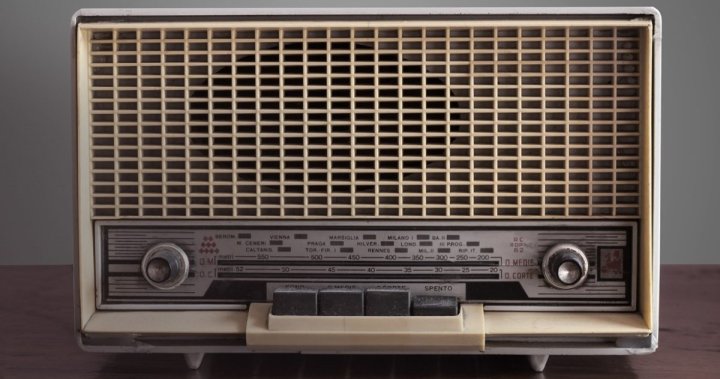Many years ago, someone asked singer Tom Waits about his favourite sounds. He replied, “a baseball game on an AM radio on a warm summer night.” He’s not wrong. To generations of radio listeners, there’s something mystical about the tinny, crackly sounds of an AM radio broadcast.
AM radio (or if you’re from certain parts of the world, mediumwave, which accounts for the “MW” marking on some radios) has been with us since the earliest days of wireless transmission more than 120 years ago.
After governments loosened the restrictions in civilian use of wireless communication after the Great War, AM radio turned into a profitable commercial enterprise after 1920, spreading all across the world.
Read more:
(May 3, 2020) As radio officially turns 100, Alan Cross explains how Canada was a major pioneer
To say that radio exploded in the 1920s and ’30s doesn’t do it justice. Instant human communication! Entertainment! Music! News! Fireside chats from government leaders! Broadcasts that travelled over hundreds or even thousands of miles! It didn’t take long for every country and territory in the world to have its own AM radio stations.
Reception could be fussy: static from thunderstorms, interference from power lines, noise from automobile ignitions, and fluorescent lights. But AM broadcasting established radio as humankind’s first mass-media tool that could be consumed in real-time.
After radio defied the predictions that it would be killed off by television in the 1950s, it turned its attention to delivering a new thing called rock’n’roll to teenagers. When transistor radios started appearing in 1954, this newly named demographic group could for the first time take their listening out of the home, away from the prying ears of parents. The music, via the radio, helped spread social, economic, political, and sexual revolutions. And it was all done on AM.
Some stations were lucky enough to have clear channel signals, which protected them from interference by other stations that broadcast on the same frequency. Canada, the U.S., Mexico, and the Bahamas had stations running their transmitters 24 hours a day at 50,000 watts (or more, in the case of Mexico, where power output could reach as high as 250,000 watts.)
These signals could be heard for hundreds of miles around during the day and thousands of miles at night thanks to something known as skywave propagation. At night, a layer of the atmosphere known as the ionosphere thickens up, acting as a giant mirror for radio signals. If the conditions were right (and they were best in the winter when the ionosphere got extra-thick), you could pick up an AM station from across the continent, sometimes for hours at a time.

My grandmother gave me my first AM radio for my sixth birthday. I hadn’t asked for one nor did my parents suggest it as a present. Until then, the only radio I knew was what came out of the set on the kitchen counter or in the car, both of which were controlled by mom and dad. My little Lloyds five-transistor opened up the planet for me from my little town on the Canadian prairies.
I’d fall asleep listening to my favourite local stations. In the winter, I’d dial around looking for distant stations — a hobby I later learned was called DXing — hoping to tune in WLS/Chicago, KOA/Denver, WLW/Cleveland, CKLW/Windsor, and any number of stations in the U.S. south with their late-night fire-and-brimstone preachers. These stations covered millions of square miles at night over dozens of states and provinces. It was magic.
One day, my father pulled up in the driveway with a massive Viking console stereo unit he picked up for $100. The radio must have had a massive internal AM antenna because that thing was capable of pulling in signals from as far away as New Orleans, Louisville, Kentucky — and even The Caribbean Beacon, which beamed sketchy religious programming at 1610 kHz from its base in Anguilla in the West Indies.
By daylight, most of my listening was done to Winnipeg stations. The city had three top 40s back then: CKY with its massive province-blanketing 50,000 clear channel signal at 580 kHz; CKRC at 630 kHz (10,000 watts, but no slouch because of its spot on the dial); and the underdog CFRW at 1470 kHz (and after 1977, 1290 kHz), and kids/teens tended to align themselves with one of them. It was common for us to fight over which station was the best. In fact, you could tell a lot about a person by which station earned their allegiance.
AM ruled for decades, even after FM started gaining acceptance in the late 1960s. FM listenership was once so low that AM operators simply simulcast their programming on their FM outlet. When broadcasting rules put an end to that in the 1970s, FM was restricted from competing with AM with rules and regulations that ensured programming on FM would be different. No one wanted to disrupt all the cash coming from AM stations.
For example, it was once illegal for a Canadian FM station to go top 40. The rules stated that FM stations couldn’t play the same song more than 18 times a week. And no more than 49 per cent of the songs on the playlist could have entered the top 40. FM was the domain of album tracks, deep cuts, and DJs who (by law) had to talk a lot more than their AM compatriots. There were spoken word requirements for things like “mosaic programming,” “surveillance,” and “foreground.” (Those rules disappeared in the 1990s.)
When I got into the business in the early 1980s, I discovered a service called California Airchecks. Every month, a cassette would arrive featuring samples of DJs on radio stations not just from the U.S. but occasionally from around the world.
These tapes were treated like gold as we studied the on-air techniques of announcers at KHJ/Los Angeles, WCFL/Chicago, and WRKO/Boston. We hung on every word by jocks like Larry Lujack, Charlie Tuna, Bobby Ocean, and dozens of others. We learned about 1050 CHUM in Toronto and CKOC in Hamilton, and how important they were to their respective markets. Yes, the slick fast-talking DJs might sound cheesy today, but that was the style back then. The goal was to be larger than life. Big personalities ruled the airwaves.
Talk about a great correspondence course for aspiring radio jocks!
When I was working at an FM station in Winnipeg, Pat, the guy who worked opposite me on the AM side (CFRW, as it turns out) had a Mazda with an especially sensitive AM radio. After our evening shifts, we’d often drive far outside the city to see what distant stations we could pull in. Pat would drive and one of us would man the old-school slide rule tuner in the dash looking sounds bouncing off the ionosphere.
The best nights were when CKJS, the city’s multi-cultural station, would sign off for transmitter maintenance, leaving the 800 kHz space wide open for DXing stations on that same frequency. We picked up CHAB/Moose Jaw, CKLW/Windsor, and the astonishingly powerful XEROK-AM in Ciudad Juárez, Mexico.
Things began to change for AM in the late 1970s as more people gravitated to FM and by 1978 had bigger audiences. Canadian music-based AM stations held on for a while longer because of our unique broadcasting rules. But the writing was on the wall.
AM radio would have all but disappeared in the 1980s had it not been for the rise of right-wing talk radio. AM couldn’t compete on musical fidelity (the physical characteristics of the AM band don’t allow for anything approaching high-fidelity sound) so owners turned to talk radio, all-news radio, sports radio, or a combination of the three. Some will point to the rise of Rush Limbaugh in the late ’80s as the thing that saved AM radio from extinction. By the middle ’90s, music-based AM radio was all but gone except in smaller markets where stations continued to be all things to everyone.
While there are still a few markets where AM stations dominate the ratings (news/talk stations in San Francisco and Washington DC come to mind), AM is on the way out. Some have flipped to FM while others have shut down completely. CKY is gone. So is CKRC. CFRW lives on as a TSN-affiliated sports station. COVID-19 isn’t helping, either.
Flipping an AM station to FM is difficult in many parts of Canada. First, this requires a whole new transmitter and antenna set-up. Second, many areas don’t have room on the FM dial for any new signals. And third, there’s a rule that no broadcaster may own more than two FMs and two AMs in the same market. If you want to flip your AM to FM and you already have two FM outlets, you’re out of luck.
And FM isn’t safe, either. Many countries outside North America, such as Norway and Switzerland, are in the process of porting FM stations to Digital Audio Broadcasting (DAB), which offers static-free CD-quality sound. Canada was all for DAB broadcasting and began experimental broadcasts decades ago, but the U.S. killed the chances of the technology ever taking hold in North American because of its insistence on adopting what’s known as HD-Radio technology.
But despite years of promotion by the industry, HD-Radio is almost dead, even though many stations do offer broadcasts that way. In fact, if you have a car that’s less than five years old, the radio is probably capable of receiving HD-Radio signals. Sadly, most of the general public doesn’t know this and really doesn’t care. It appears that North America may skip over-the-air digital signals entirely and move right to internet protocol broadcasting, something that could very well happen with the upcoming 5G technology. When we do make that switch, AM will most surely perish.
Like Tom Waits, I still treasure the sounds of AM radio and its crackly audio. Listening to a hockey or baseball game on FM doesn’t feel right. It’s too sanitized. And would a show like Coast to Coast AM sound as spooky and enthralling on FM? I don’t think so.
Listen while you can. Especially at night. You never know what marvels you might pick up.
—
Alan Cross is a broadcaster with Q107 and 102.1 the Edge and a commentator for Global News.
Subscribe to Alan’s Ongoing History of New Music Podcast now on Apple Podcast or Google Play
© 2021 Global News, a division of Corus Entertainment Inc.


